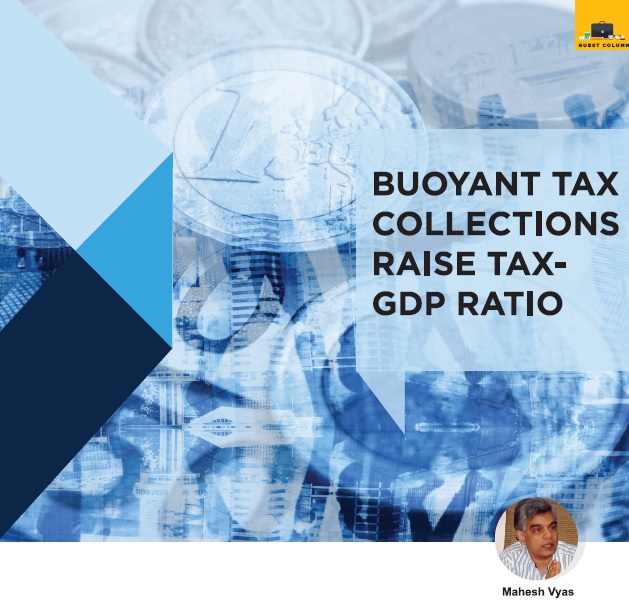 By Mahesh Vyas
By Mahesh Vyas
Growth in gross tax collections by central government slowed down to 13.4 per cent in 2017-18, but tax collections are budgeted to grow by 18.8 per cent in 2018-19. Average growth in tax collections has been in excess of 15 per cent per annum and this will accelerate in 2018-19.
The tax-to-GDP ratio reached its highest level of 11.6 per cent in 2017-18. According to the budget estimates, this would rise further to 12.1 per cent in 2018-19. The rising ratio of taxes to GDP is not a very welcome trend. In the spirit of liberalisation and recent tax reforms, we expect government to not claim a rising share of our income. Celebrating a rising tax-GDP ratio is therefore misplaced. Economic Survey 2016-17 had argued that after controlling for the level of economic development, India neither under-taxes nor under-spends. So, there is no argument in favour of raising the tax-to-GDP ratio.
Changes in tax collections reflect changes in one or more of four factors – changes in the tax rate, changes in economic activity, changes in application of taxes and changes in compliance. Independent of their individual or combined contribution to changes in tax collection, the overall tax-GDP ratio must not rise.
We have undertaken our greatest tax reform by introducing the goods and services tax. GST, more than any other tax, should reduce the incidence of tax because it removes the cascading impact of indirect taxes that happens in the absence of a value-added tax or in the absence of the concept of tax input credit. Since the GST accounts for most of the indirect taxes and almost a third of all taxes in 2018-19, its eventual decline should see the tax-GDP ratio fall in due course.
The extraordinarily stringent compliance requirements under the GST regime ensure that potential leakages are well plugged. It would be useful to bring petroleum and other sectors currently out of the GST regime into the system to ensure that there are no leakages.
The finance minister has indicated that there is room to reduce the GST rates/slabs. This would be most welcome.
Direct and indirect taxes account for about 6 per cent of GDP each. Both have been rising but, the increase in indirect taxes has been faster.
Indirect taxes have grown faster as the tax net was spread to a larger number of services every year since the launch of the service tax. In recent years, the persistent increase in tax rates applicable on petroleum products has raised indirect tax collections of the government. Since the use of private vehicles has been rising and it is quite price inelastic, the government found a low-hanging fruit in falling petroleum prices to haul a highway heist. This robbed the country a chance to move to market driven prices for petroleum products. If consumers were allowed to enjoy the benefits of falling prices they would be willing to pay the price of rising prices when that happens. But now, after having been made to forego the benefits of low crude prices, consumers will be loath to bear the cost of rising prices.
In 2018-19, direct taxes are projected to rise by 14.4 per cent and indirect taxes are projected to rise by 19.2 per cent. Income tax growth would drive direct taxes. Indirect taxes are driven by the shift in favour of GST which is expected to see a 67 per cent increase.
Corporate taxes have been growing annually in single digit which, is much lower than the growth in nominal GDP. This average annual growth in corporate taxes has been in the range of 6 to 11 per cent since 2011-12. As a result, the share of corporate taxes has been falling. The fall began in 2010-11 and exacerbated in 2015-16 and 2016-17. This is a reflection of the stressed conditions of the corporate sector during these years.
Revised estimates for 2017-18 indicate that corporate taxes are bouncing back as these taxes are expected to increase by 16.3 per cent. However, these are expected to grow further by a modest 10.2 per cent (BE over RE) during 2018-19. Tax rates have been reduced partly. But, the main factor impacting corporate taxes is its poor growth in profits. According to CMIE’s Prowess database, between 2011-12 and 2016-17 corporate profits grew at the rate of 1.2 per cent per annum while nominal GDP grew at 12.3 per cent per annum.
Income tax (direct taxes paid by non-corporates) has seen a steady increase. Its share in total central taxes rose to a record 23 per cent in 2017-18. These taxes grew 24.7 per cent in 2016-17 and then 24.1 per cent in 2017-18. This reflects greater compliance. The finance minister mentioned in his speech that 8.55 million new taxpayers filed their returns in 2016-17 compared to 6.63 million new taxpayers filing returns in 2015-16. The effective number of tax payers (adding tax filers and those who did not file returns but paid tax by way of advance tax or tax deduction at source) increased from 64.7 million as of April 2014 to 82.7 million as of March 2017.
As the number of assessees of income tax is rising, there is a case for reducing income tax rates as it is important that in a liberalised economy the share of taxes in GDP should not keep rising.










